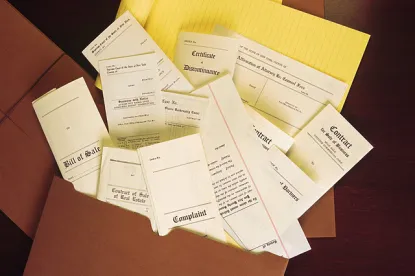We wrote here previously regarding the Sixth Circuit’s decision in Shane Group v. Blue Cross Blue Shield of Michigan vacating a class action settlement because the district court improperly refused to unseal the parties’ substantive filings. In revisiting the district court’s sealing orders, the Court of Appeals found that the parties’ cursory justifications for their sealing requests were “patently inadequate.” And based on this failure to elucidate reasons for sealing, the Sixth Circuit vacated every one of the district court’s sealing orders. Since its decision in June, the Sixth Circuit had occasion to interpret and apply Shane Group, and in doing so, offered key learnings for litigants seeking to toe the line for compliance with the Sixth Circuit’s newly-pronounced standard.
In Rudd Equip. Co., Inc. v. John Deere Constr. & Forestry Co., the Sixth Circuit affirmed the district court’s order granting a supplier’s motion to unseal the entire docket in an action brought by a dealer. Though the district court initially granted the dealer’s motion to seal early in the litigation, it later revisited the order upon the supplier’s motion to unseal. At the time of its initial sealing decision, the district court entered a blanket order without making any findings or setting forth any conclusions justifying sealing. That alone, the Sixth Circuit concluded, would have been enough reason for the district court to vacate its earlier sealing decision. Furthermore, in contesting the motion to seal, the supplier could not identify any “trade secret, or privacy right of third parties, that a seal might legitimately protect.” Though the supplier argued that “the very fact of the lawsuit” could create “devastating consequences for its business,” which could cause a loss of customers, goodwill, and jobs, such justifications, according to the Sixth Circuit, actually weighed in favor of public access. Citing Shane Group, the Court noted that “[T]he greater the public interest in the litigation’s subject matter, the greater the showing necessary to overcome the presumption of access.”
Rudd demonstrates that harm to business alone will not be enough to keep a case under seal. And even where parties can successfully obtain sealing orders early on in litigation, if the justification for sealing does not meet the exacting standards of Shane Group, litigants risk the court revisiting that order.
In Beauchamp v. Fed. Home Loan Mortgage Corp., the Sixth Circuit sua sponte revisited the district court’s decision to seal summary judgment filings, which included contracts and accompanying documents. Citing Shane Group, the Court noted that, though neither party objected to sealing the records, the district court had a duty to set forth specific findings to justify sealing. Although a protective order had been entered, the order contemplated that any document designated confidential shall be sealed. The Sixth Circuit observed that hundreds of documents had been filed under seal at the summary judgment phase without the district court having made any findings, and neither party setting forth “compelling reasons” to seal such material nor an assertion that such a sealing order would be “narrowly tailored.” Instead, the only record entry regarding the sealing was a note that counsel called the district court requesting that the motion be filed under seal, and that such a request would be granted pursuant to the protective order. Thus, in the absence of any record justification, the Sixth Circuit vacated the orders to seal documents.
Beauchamp makes clear the pronouncement from Shane Group that reliance on protective orders alone is not enough to justify sealing orders in the Sixth Circuit. Counsel must be prepared to file a motion to seal with each docket entry explaining the justification for non-disclosure, or risk the Court of Appeals finding that there is no basis for sealing documents. Although protective orders remain useful and important tools to govern discovery, Shane Group teaches that different—and often more rigorous—considerations apply when documents are placed in the record.



 />i
/>i

